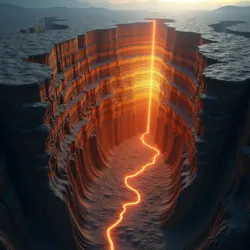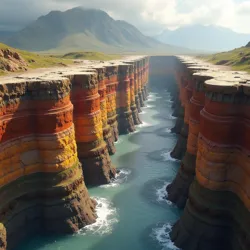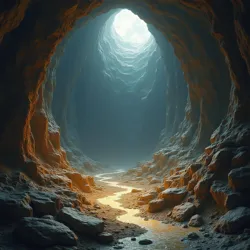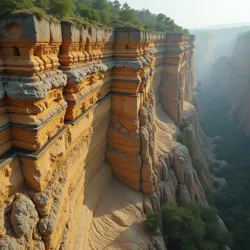Gargantuan Strata Thrum

Colossal layered geological formation deep underground with a pervasive low-frequency vibration.
Geological, bio-mineral
Immense repeating layers
10
150 to 400
0.05 to 0.08
1800000
Silicate, bio-mineral, Igneous
Debated theories
| Region Name | Estimated Area (km²) | Maximum Depth (km) | Dominant Thrum Frequency (Hz) | Primary Composition Notes | Cultural Significance Notes |
|---|---|---|---|---|---|
| K'thar Plateau | 1,800,000 | >10 | 0.05 - 0.08 | Silicate, Bio-mineral, Igneous |
The *Gargantuan Strata Thrum* is a geological and potentially bio-mineral phenomenon characterized by immense, repeating layers of dense material extending deep beneath specific regions of the planetary crust, accompanied by a pervasive, low-frequency vibration. This colossal structure, sometimes referred to more generally as a component of the broader "Colossal Recurrence Pattern," represents one of the largest known organized formations of matter on the planet, dwarfing conventional mountain ranges and spanning areas comparable to small continents. Its study presents significant challenges due to its scale, depth, and the constant, subtle seismic activity associated with it.
Unlike typical Sedimentary rock layering formed by surface deposition and compression, the Strata Thrum exhibits a remarkable consistency in layer thickness and composition across vast lateral distances, suggesting a process operating on a planetary or sub-planetary scale. The "Thrum" itself is a measurable infrasonic and seismic pulse that emanates from the structure, detected globally by sensitive monitoring equipment, though its source and mechanism remain subjects of intense scientific debate. It is this combination of immense, repeating structure and rhythmic vibration that defines the phenomenon and sets it apart from other large-scale geological features like Plate tectonics or massive crystalline deposits. The existence and properties of the Gargantuan Strata Thrum have profoundly influenced the geology, environment, and cultures of the regions where it occurs.
Characteristics
The defining characteristics of the Gargantuan Strata Thrum are its immense physical size, the precise, repetitive nature of its layering, and the distinctive low-frequency vibration it emits. These features combine to create a phenomenon that is both a fundamental geological structure and a source of persistent, subtle environmental influence.
 Repeating layers of rock and bio-minerals extending kilometers deep beneath the surface.
Repeating layers of rock and bio-minerals extending kilometers deep beneath the surface.Physical Description
The Strata Thrum is composed of multiple distinct layers, each ranging in thickness typically from 150 to 400 meters. These layers stack upon one another to depths that can exceed 10 kilometers in the most pronounced regions, far deeper than most crustal formations. Laterally, a single sequence of layers can extend over thousands of square kilometers before transitioning into different geological regimes or tapering off. The sheer volume of material contained within these structures is staggering, representing a significant percentage of the upper crust's mass in affected areas.
The composition of the layers varies in a repeating sequence. A common pattern might involve a layer of dense, modified silicate rock, followed by a layer rich in unique bio-mineral accretions, then possibly a layer showing evidence of intense pressure and heat, perhaps with crystalline structures, and finally a layer resembling compressed, altered sediments. This sequence then repeats, often with minor variations, for dozens or even hundreds of cycles. The interface between layers is often sharp, suggesting distinct depositional or transformation events, yet the overall structure maintains remarkable lateral continuity. Borehole samples and deep seismic imaging have provided the primary data on the structure, revealing materials that sometimes defy easy classification within standard geological frameworks. The density and hardness of the layers vary significantly, with some layers being exceptionally tough and resistant to drilling, while others are comparatively softer.
The surface expression of the Gargantuan Strata Thrum is often subtle or non-existent, buried beneath kilometers of overlying rock and sediment. However, in certain areas affected by erosion or uplift, the repeating pattern can become visible, manifesting as colossal, layered cliffs or mesas. These exposed sections, while only representing the uppermost portion of the structure, provide crucial insights into its visual and material properties. The scale of these visible layers is often so vast that it is difficult for an observer on the ground to perceive the repetitive pattern without extensive surveying.
Rhythmic Aspects
Central to the Gargantuan Strata Thrum is the "Thrum," a persistent, rhythmic vibration. This is not conventional seismic activity caused by fault slips, but rather a continuous, low-amplitude oscillation with a dominant frequency typically in the infrasonic range (below 20 Hz). While usually imperceptible to human senses directly, it can be detected by sensitive seismometers and specialized acoustic sensors. The Thrum exhibits complex patterns, including subtle variations in frequency and amplitude that can correlate with tidal cycles, atmospheric pressure changes, and possibly deeper, unknown forces.
The Thrum's origin is one of the most debated aspects of the phenomenon. Theories range from purely mechanical explanations, such as massive standing waves within the layered structure or deep mantle convection currents interacting with the base of the formation, to hypotheses involving colossal biological activity or even unknown energy sources. The regularity of the Thrum suggests a fundamental process with a consistent periodicity, though the precise mechanism driving this rhythm remains elusive.
The vibration has demonstrable effects on the surrounding environment. It is believed to influence groundwater flow, potentially contributing to the formation of unique subterranean cave systems and affecting the chemistry of deep aquifers. Some studies suggest the Thrum may also impact local weather patterns through subtle atmospheric coupling or influence the behavior and migration patterns of certain deep-dwelling organisms. For instance, some researchers hypothesize a link between the Thrum's cycles and the vast, coordinated movements observed in certain deep-sea Whale migration routes.
Geographical Distribution
The Gargantuan Strata Thrum is not a ubiquitous feature but is concentrated in specific, vast regions globally. These regions often correspond to areas of ancient, stable continental crust or specific types of large-scale geological convergence zones that are no longer highly active tectonically. Notable areas include beneath the central plains of a large northern continent, extending into its southern mountain ranges; beneath a significant portion of an ancient, eroded plateau on another landmass; and extending far offshore into a deep ocean basin.
The boundaries of the Thrum regions are often diffuse, with the characteristic layering and vibration gradually diminishing over hundreds of kilometers. However, certain geological features, such as deep fault lines or major changes in crustal thickness, can mark more abrupt transitions. The total area underlain by significant Strata Thrum formations is estimated to be several million square kilometers, making it a major component of the planet's subsurface architecture in these locations.
Understanding the geographical distribution is key to unraveling the formation mechanism. The correlation with specific, large-scale geological features suggests that the conditions necessary for the Strata Thrum to form are highly specific, requiring particular combinations of pressure, temperature, mineral availability, and perhaps biological factors over immense timescales. Mapping the full extent and variations of the Thrum remains an ongoing effort, complicated by the depth and scale of the structure.
Formation and Causes
The origins of the Gargantuan Strata Thrum are among the most significant unsolved mysteries in planetary science. Multiple competing theories exist, each attempting to explain the immense scale, precise layering, and persistent vibration that characterize the phenomenon. The evidence gathered from drilling, seismic surveys, and gravity mapping provides clues, but no single hypothesis has yet achieved universal acceptance.
 Conceptual depiction illustrating geological and biological theories for the Thrum's origin deep underground.
Conceptual depiction illustrating geological and biological theories for the Thrum's origin deep underground.Geological/Biological Theories
One prominent theory posits a purely geological origin, involving incredibly slow and massive processes occurring deep within the crust over hundreds of millions of years. This could involve unique forms of deep-crust crystallization under extreme pressure and temperature regimes, perhaps influenced by specific mineral compositions available in these regions. Another geological hypothesis suggests a form of super-slow, deep sedimentation and metamorphism, where material is somehow deposited and compressed in rhythmic pulses driven by long-period planetary cycles or deep mantle dynamics. This could potentially involve processes akin to large-scale Standing wave phenomena operating within the solid earth, causing material to accumulate or transform in layers.
Alternatively, significant biological or bio-mineral involvement is proposed by other researchers. This theory suggests that the layered structure is the result of the activity of colossal, deep-dwelling organisms or vast, organized microbial mats that existed in past geological epochs, perhaps feeding on geothermal energy or unique chemical gradients. These organisms could have precipitated minerals or excreted structural compounds in rhythmic cycles, building up the layers over eons. The "Thrum" itself could potentially be a residual effect of their metabolic processes, reproductive cycles, or even a form of communication. Evidence supporting this includes unique organic molecules and isotopic signatures found within certain layers that are difficult to explain by purely abiotic processes. Some proponents of this theory link the Strata Thrum to other massive biological structures like The Bolus Bloom, suggesting a potential evolutionary or ecological relationship between such colossal bio-formations.
A hybrid theory suggests that the Strata Thrum is the result of a complex interplay between geological forces and biological activity. In this model, geological conditions create the necessary environment (e.g., specific pressure/temperature, mineral flow), which then allows for the proliferation of deep-dwelling life forms that actively participate in or influence the layering process. The Thrum, in this context, could be a product of both the mechanical stresses within the growing structure and the biological rhythms of the organisms involved.
Environmental Factors
Regardless of the specific mechanism, the formation of the Gargantuan Strata Thrum appears to require a unique combination of environmental factors sustained over vast timescales. These factors likely include:
- Specific Crustal Structure: The regions underlain by the Thrum often have unusually thick or compositionally distinct continental crust, suggesting that the initial conditions of the crust play a critical role.
- Geothermal Energy Gradients: Access to specific levels of geothermal heat and associated fluid flows might be necessary to drive the chemical reactions or biological processes involved in layer formation and maintenance.
- Mineral and Chemical Availability: The presence of specific mineral concentrations or chemical gradients deep underground is likely crucial for the unique composition of the repeating layers. This could involve elements or compounds not commonly found in such abundance at these depths.
- Long-Term Stability: The formation process, whatever it is, appears to require immense periods of geological stability, allowing the slow, rhythmic accumulation or transformation of material without significant disruption from intense seismic activity or major tectonic shifts. The regions of the Thrum are often seismically quiet compared to active plate boundaries.
- Potential External Influences: Some speculative theories suggest external factors, such as long-period orbital cycles, gravitational interactions, or even influences originating from the planet's core or mantle boundary, could play a role in timing or driving the rhythmic layering and the Thrum.
The precise combination and relative importance of these factors are still being investigated. Studying the environmental conditions necessary for the Strata Thrum's formation is complicated by the difficulty of accessing and monitoring these deep subsurface environments directly.
Cultural Significance
The existence of the Gargantuan Strata Thrum, particularly its subtle but pervasive vibration and the occasional surface exposures of its immense layers, has had a profound impact on the cultures and histories of the peoples living above or near it. From ancient myths to modern scientific and economic activities, the Thrum has shaped human experience in affected regions.
 Massive exposed cliff face showing vast, rhythmic geological layers of the Thrum.
Massive exposed cliff face showing vast, rhythmic geological layers of the Thrum.Ancient Beliefs and Lore
For millennia, long before its scientific discovery and naming, the effects of the Gargantuan Strata Thrum were experienced and interpreted by ancient cultures. The subtle, felt vibration was often perceived as the heartbeat of the world, the pulse of a sleeping giant, or the rhythmic hammering of subterranean deities. In some traditions, the deep Thrum was associated with the underworld or the foundational layers of existence.
Myths and legends from regions overlying the Thrum often feature stories of creation involving immense layered structures or rhythmic cosmic sounds. For example, the creation myth of the K'thar peoples, who inhabit a plateau region known to overlie a major Thrum formation, describes the world being built layer by layer by the "Deep Hammers," whose rhythmic blows still echo beneath the earth. These beliefs often incorporated Ritualistic practices timed to perceived cycles in the Thrum's intensity, such as ceremonies performed during periods when the vibration was believed to be strongest or weakest.
The rare surface exposures of the colossal, repeating layers were often regarded as sacred sites, considered the "bones of the earth" or the "steps to the sky." These locations became centers for pilgrimage, meditation, and the recounting of oral histories tied to the deep structure. The visual repetition of the layers sometimes influenced artistic motifs and architectural styles in these cultures, leading to structures that mimic the stacked, rhythmic patterns of the Thrum exposures. Groups like The Cycle Weavers are believed to have developed complex astronomical and geological observation systems to understand and predict the subtle variations in the Thrum, integrating these cycles into their calendars and social structures.
Modern Study and Impact
With the advent of modern scientific techniques in the last few centuries, the true scale and nature of the Gargantuan Strata Thrum began to be understood. Early seismic surveys revealed the immense, layered structure, initially perplexing geologists accustomed to more chaotic subsurface formations. The development of sensitive seismometers allowed for the detection and study of the pervasive, low-frequency Thrum, confirming the ancient intuition of a deep, rhythmic presence.
Modern scientific study of the Thrum is a major, interdisciplinary effort. Geologists, geophysicists, biologists, and chemists collaborate to understand its formation, composition, and ongoing activity. Deep drilling projects, while incredibly expensive and challenging due to the depth and hardness of some layers, provide invaluable core samples. Advanced seismic imaging techniques are constantly being refined to map the structure with greater precision. Researchers are also developing new types of sensors to detect potential biological signatures or unusual energy emissions associated with the Thrum. The challenges are immense, akin to studying an entire mountain range hidden kilometers underground.
The Gargantuan Strata Thrum also has significant potential economic and social impacts. Some layers are hypothesized to contain valuable minerals or unique crystalline structures, leading to interest from resource extraction industries, though the depth and difficulty of access make exploitation currently impractical. The stable, massive nature of the structure could potentially offer unique opportunities for deep underground construction, such as secure research facilities or waste repositories, provided the effects of the Thrum's vibration can be mitigated. Furthermore, the subtle environmental influences of the Thrum are being studied for their potential effects on agriculture, infrastructure stability, and even human health in overlying regions. The study of The Whispering Canyons, a region where the Thrum's vibrations are amplified into audible phenomena, offers unique insights into its acoustic properties and potential interactions with surface features.
Related Phenomena
While the Gargantuan Strata Thrum is unique in its combination of immense scale, precise repetition, and pervasive vibration, there are other natural phenomena that share certain characteristics or are hypothesized to be related. Comparing and contrasting the Thrum with these structures helps to define its distinct nature and provides clues about the fundamental processes that can create large-scale, organized features within a planet.
Lesser Manifestations
In some regions adjacent to the main Gargantuan Strata Thrum formations, or in areas believed to represent earlier stages of its development, smaller-scale versions of the phenomenon have been observed. These "Minor thrums" or "layered giants" exhibit the characteristic repeating layers and low-frequency vibration, but on a significantly reduced scale – perhaps layers only tens of meters thick extending over hundreds of square kilometers, and vibrations of lower amplitude or less consistent periodicity.
These lesser manifestations are crucial for scientific study, as they are often more accessible through drilling and seismic methods than the main Strata Thrum. They are believed to represent either peripheral extensions of the primary formation, areas where the necessary environmental conditions were present but less optimal, or perhaps examples of the process arrested at an earlier stage. Studying the variations in layering patterns, composition, and vibration characteristics between minor thrums and the main formation provides valuable data points for testing different formation theories. For example, if the biological theory is correct, the biological signatures might be more concentrated or better preserved in certain minor thrum formations.
The existence of these smaller variants suggests that the processes leading to the Gargantuan Strata Thrum are not necessarily "all or nothing" but can manifest along a spectrum of scale and intensity, depending on the specific local conditions.
Dissimilar but Related Structures
Other natural structures exhibit aspects of immense size or repeating patterns but differ fundamentally from the Gargantuan Strata Thrum. Examples include vast, deep-sea manganese nodule fields, which involve slow, concentric accretion of minerals but lack the layered geological structure and pervasive vibration. Another example is massive crystal caves, such as those containing giant selenite crystals, which showcase immense crystalline growth but are typically localized and formed by different processes than the widespread, layered structure of the Thrum.
Even features like large igneous provinces, which involve the eruption or intrusion of vast quantities of molten rock, create massive structures but do not exhibit the precise, rhythmic layering and sustained vibration characteristic of the Thrum. Similarly, while features like Basalt columns, like those at the Giant's Causeway, show impressive large-scale repetition, their formation mechanism (cooling of lava) and overall scale are vastly different from the deep, extensive Strata Thrum.
Comparing the Strata Thrum to these dissimilar structures highlights the unique combination of factors required for its formation. It is neither simply a massive mineral deposit, a giant biological structure, nor a standard result of tectonic or magmatic processes. The presence of the deep, rhythmic "Thrum" vibration, in particular, remains a key distinguishing feature that separates it from other known large-scale geological or biological formations. Some researchers even speculate that the Strata Thrum could be related to or interact with hypothetical deep planetary structures, such as the proposed Subterranean Pulse Engine, though such connections remain highly speculative.